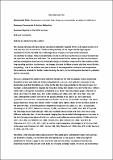Por favor, use este identificador para citar o enlazar a este item:
http://hdl.handle.net/10261/340144COMPARTIR / EXPORTAR:
 SHARE SHARE
 CORE
BASE CORE
BASE
|
|
| Visualizar otros formatos: MARC | Dublin Core | RDF | ORE | MODS | METS | DIDL | DATACITE | |

| Título: | Atmospheric molecular blobs shape up circumstellar envelopes of AGB stars |
Autor: | Velilla Prieto, L. CSIC ORCID; Fonfría, J. P.; Agúndez, Marcelino CSIC ORCID; Castro-Carrizo, A.; Guélin, M.; Quintana-Lacaci, G. CSIC ORCID; Cherchneff, I.; Joblin, C.; McCarthy, M. C.; Martín-Gago, José A. CSIC ORCID ; Cernicharo, José CSIC ORCID | Fecha de publicación: | 17-may-2023 | Editor: | Nature Publishing Group | Citación: | Nature 617: 696–700 (2023) | Resumen: | During their thermally pulsing phase, asymptotic giant branch (AGB) stars eject material that forms extended dusty envelopes1. Visible polarimetric imaging found clumpy dust clouds within two stellar radii of several oxygen-rich stars2-6. Inhomogeneous molecular gas has also been observed in multiple emission lines within several stellar radii of different oxygen-rich stars, including W Hya and Mira7-10. At the stellar surface level, infrared images have shown intricate structures around the carbon semiregular variable R Scl and in the S-type star π1 Gru11,12. Infrared images have also shown clumpy dust structures within a few stellar radii of the prototypical carbon AGB star IRC+10°216 (refs. 13,14), and studies of molecular gas distribution beyond the dust formation zone have also shown complex circumstellar structures15. Because of the lack of sufficient spatial resolution, however, the distribution of molecular gas in the stellar atmosphere and the dust formation zone of AGB carbon stars is not known, nor is how it is subsequently expelled. Here we report observations with a resolution of one stellar radius of the recently formed dust and molecular gas in the atmosphere of IRC+10°216. Lines of HCN, SiS and SiC2 appear at different radii and in different clumps, which we interpret as large convective cells in the photosphere, as seen in Betelgeuse16. The convective cells coalesce with pulsation, causing anisotropies that, together with companions17,18, shape its circumstellar envelope. | Descripción: | 19 pags., 4 + 10 figs. | Versión del editor: | https://doi.org/10.1038/s41586-023-05917-9 | URI: | http://hdl.handle.net/10261/340144 | DOI: | 10.1038/s41586-023-05917-9 | ISSN: | 0028-0836 |
| Aparece en las colecciones: | (CFMAC-IFF) Artículos (CAB) Artículos |
Ficheros en este ítem:
| Fichero | Descripción | Tamaño | Formato | |
|---|---|---|---|---|
| accesoRestringido.pdf | 15,38 kB | Adobe PDF |  Visualizar/Abrir | |
| Información complementaria.pdf | Supplementary information | 446,2 kB | Adobe PDF |  Visualizar/Abrir |
CORE Recommender
SCOPUSTM
Citations
2
checked on 29-abr-2024
WEB OF SCIENCETM
Citations
2
checked on 24-feb-2024
Page view(s)
22
checked on 03-may-2024
Download(s)
23
checked on 03-may-2024
Google ScholarTM
Check
Altmetric
Altmetric
NOTA: Los ítems de Digital.CSIC están protegidos por copyright, con todos los derechos reservados, a menos que se indique lo contrario.
